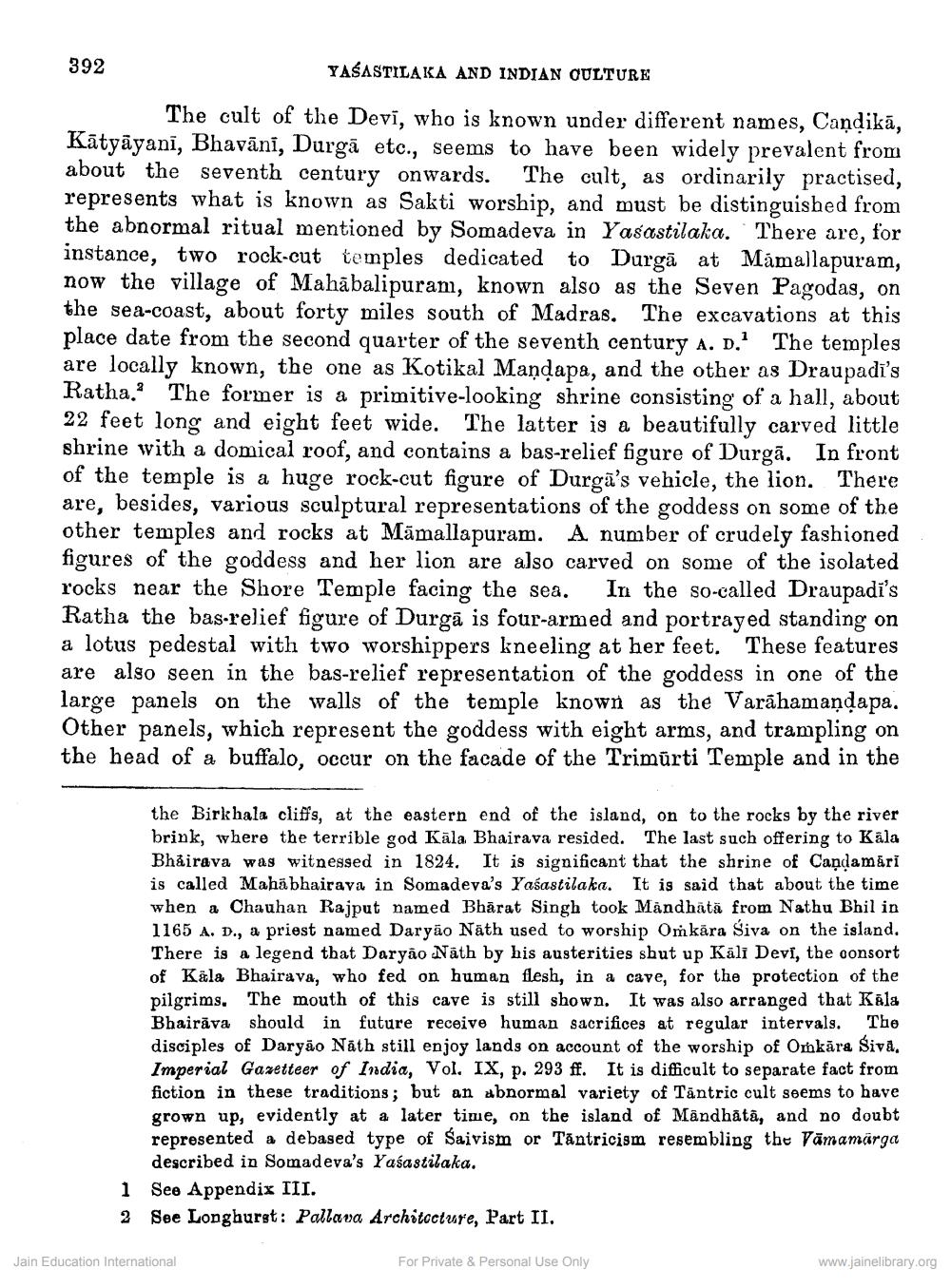________________
392
YAŠASTILAKA AND INDIAN CULTURE
The cult of the Devi, who is known under different names, Candikā, Kātyāyani, Bhavāni, Durgā etc., seems to have been widely prevalent from about the seventh century onwards. The cult, as ordinarily practised, represents what is known as Sakti worship, and must be distinguished from the abnormal ritual mentioned by Somadeva in Yasastilaka. There are, for instance, two rock-cut temples dedicated to Durgā at Mamallapuram, now the village of Mahābalipuram, known also as the Seven Pagodas, on the sea-coast, about forty miles south of Madras. The excavations at this place date from the second quarter of the seventh century A. D.' The temples are locally known, the one as Kotikal Mandapa, and the other as Draupadi's Ratha. The former is a primitive-looking shrine consisting of a hall, about 22 feet long and eight feet wide. The latter is a beautifully carved little shrine with a domical roof, and contains a bas-relief figure of Durgā. In front of the temple is a huge rock-cut figure of Durga's vehicle. the li are, besides, various sculptural representations of the goddess on some of the other temples and rocks at Mamallapuram. A number of crudely fashioned figures of the goddess and her lion are also carved on some of the isolated rocks near the Shore Temple facing the sea. In the so-called Draupadi's Ratha the bas-relief figure of Durgā is four-armed and portrayed standing on a lotus pedestal with two worshippers kneeling at her feet. These features are also seen in the bas-relief representation of the goddess in one of the large panels on the walls of the temple known as the Varāhamaņdapa. Other panels, which represent the goddess with eight arms, and trampling on the head of a buffalo, occur on the facade of the Trimurti Temple and in the
the Birkhala cliffs, at the eastern end of the island, on to the rocks by the river brink, where the terrible god Kala Bhairava resided. The last such offering to Kala Bhairava was witnessed in 1824. It is significant that the shrine of Candamári is called Mahabhairava in Somadeva's Yaśastilaka. It is said that about the time when a Chauhan Rajput named Bhārat Singh took Mandhātā from Nathu Bhil in 1165 A. D., a priest named Daryão Näth used to worship Omkära Siva on the island. There is a legend that Daryão Nath by his austerities shut up Kāli Devi, the consort of Kala Bhairava, who fed on human flesh, in a cave, for the protection of the pilgrims. The mouth of this cave is still shown. It was also arranged that Kāla Bhairāva should in future receive human sacrifices at regular intervals. The disciples of Daryão Náth still enjoy lands on account of the worship of Omkāra Siva. Imperial Gazetteer of India, Vol. IX, p. 293 ff. It is difficult to separate fact from fiction in these traditions, but an abnormal variety of Tāntric cult seems to have grown up, evidently at a later time, on the island of Mândhātā, and no doubt represented a debased type of Saivism or Tántricism resembling the Vāmamarga
described in Somadeva's Yaśastilaka. 1 See Appendix III. 2 See Longhurst: Pallava Architecture, Part II.
Jain Education International
For Private & Personal Use Only
www.jainelibrary.org




